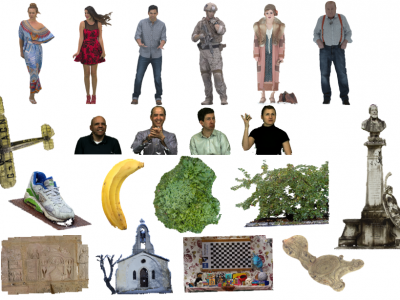Virtual Reality
The video demonstrates an accurate, low-latency body tracking approach for VR-based applications using Vive Trackers. Using a HTC Vive headset and Vive Trackers, an immersive VR experience, by animating the motions of the avatar as smoothly, rapidly and as accurately as possible, has been created. The user can see her from the first-person view.
- Categories:
 703 Views
703 Views
Investigating how people perceive virtual reality videos in the wild (i.e., those captured by everyday users) is a crucial and challenging task in VR-related applications due to complex authentic distortions localized in space and time. Existing panoramic video databases only consider synthetic distortions, assume fixed viewing conditions, and are limited in size. To overcome these shortcomings, we construct the VR Video Quality in the Wild (VRVQW) database, which is one of the first of its kind, and contains 502 user-generated videos with diverse content and distortion characteristics.
- Categories:
 62 Views
62 Views
Extended reality (XR) head-mounted displays (HMDs) are increasingly starting to rely on wireless task
offloading in a bid to allow unobstructed XR user movement, while still rendering high-resolution video on
a remote processing node. An example is the Oculus (Meta) Quest 2. However, congestion and reliability
issues associated with the wireless network can cause high latency and an overall low quality of service (QoS).
Therefore, understanding XR user mobility is of vital importance for supporting XR applications in future
wireless networks.
- Categories:
 142 Views
142 ViewsThis dataset provides valuable insights into hand gestures and their associated measurements. Hand gestures play a significant role in human communication, and understanding their patterns and characteristics can be enabled various applications, such as gesture recognition systems, sign language interpretation, and human-computer interaction. This dataset was carefully collected by a specialist who captured snapshots of individuals making different hand gestures and measured specific distances between the fingers and the palm.
- Categories:
 749 Views
749 Views
Raw data files for Exp 1 and Exp 2: My virtual self: the role of movement in children’s sense of embodiment
Hayley Dewe*, Janna M. Gottwald*, Laura-Ashleigh Bird, Harry Brenton, Marco Gillies, & Dorothy Cowie (2021)
- Categories:
 101 Views
101 Views
Sixteen omnidirectional images, taken from Salient360! [1] dataset, were used in the subjective test. The viewport videos are rendered using rectilinear projection. The pairwise comparison (PC) was selected as the subjective test method. More details on the viewport videos and the subject test procedures can be found in [2].
- Categories:
 93 Views
93 ViewsWe focus on subjective and objective Point Cloud Quality Assessment (PCQA) in an immersive environment and study the effect of geometry and texture attributes in compression distortion. Using a Head-Mounted Display (HMD) with six degrees of freedom, we establish a subjective PCQA database named SIAT Point Cloud Quality Database (SIAT-PCQD). Our database consists of 340 distorted point clouds compressed by the MPEG point cloud encoder with the combination of 20 sequences and 17 pairs of geometry and texture quantization parameters.
- Categories:
 570 Views
570 Views
Lorem Ipsum is simply dummy text of the printing and typesetting industry. Lorem Ipsum has been the industry's standard dummy text ever since the 1500s, when an unknown printer took a galley of type and scrambled it to make a type specimen book. It has survived not only five centuries, but also the leap into electronic typesetting, remaining essentially unchanged. It was popularised in the 1960s with the release of Letraset sheets containing Lorem Ipsum passages, and more recently with desktop publishing software like Aldus PageMaker including versions of Lorem Ipsum.
- Categories:
 118 Views
118 ViewsNextmed project is a software platform for the segmentation and visualization of medical images. It consist on a series of different automatic segmentation algorithms for different anatomical structures and a platform for the visualization of the results as 3D models.
This dataset contains the .obj and .nrrd files that correspond to the results of applying our automatic lung segmentation algorithm to the LIDC-IDRI dataset.
This dataset relates to 718 of the 1012 LIDC-IDRI scans.
- Categories:
 698 Views
698 Views

